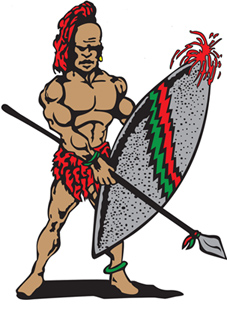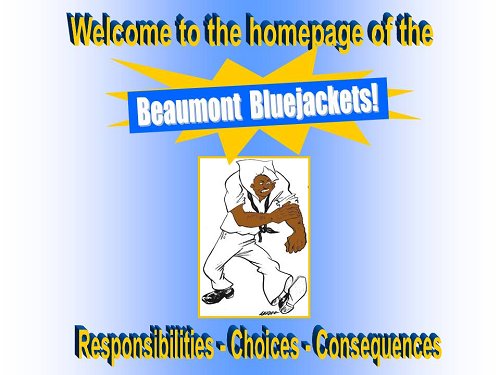Jim Crow Museum
1010 Campus Drive
Big Rapids, MI 49307
[email protected]
(231) 591-5873
After seeing the Philadelphia 76ers new alternative logo, I wondered how many African Americans have been depicted as team logos and mascots?
--James Owens
Philadelphia, Pennsylvania
|
My hope in responding to this question is to generate interest in research by friends of the museum. Because there have been thousands of sports teams from high school to minor leagues to professional leagues, it is virtually impossible to search all the historical logos and mascots to find African American representations, either positive or negative. However, I was able to find some logos and mascots designed after African American imagery. I hope our audience will help lead us to more. Considering the numerous caricatures of African Americans in advertising, marketing, toys, games, and entertainment. I was rather relieved that I was not able to find hundreds of caricatured images of black Americans used as logos and mascots. That is not to say they don’t exist, I just wasn’t able to find many. There are over 2000 Native American mascots, logos, or references for athletic teams in the United States (Native American mascots). Some are blatantly offensive, some are “honoring,” and some are a bit ambiguous. Many have changed their names, but still the controversy rages over the remaining teams using Native American heritage and images as logos and mascots. |
 |
|
As far as African Americans used as mascots, logos, or referenced, I found many that were associated with the Negro leagues, (football, basketball, and baseball leagues), and some used African countries and tribes in the team names. For example, the Indianapolis Clowns franchise had previously been called the Miami Ethiopian Clowns (History of Indianapolis Clowns). Teams like the Ethiopian Clowns, the Zulu Cannibal Giants from Louisville, Kentucky, and the Borneo Cannibal Giants, were famed for their comedic style of play and vaudeville type routines (Black Ball). In some contests, the players “painted their faces, put rings in their noses, and played in straw dresses” (I was Right on Time). One theory is that the popularity of the Harlem Globetrotters could be attributed to the popularity of the “pepperball and shadowball” performances of these teams. (Black Ball). |
|
|
Although an African American was not used as a logo or mascot, there were other ways that black athletes were caricatured on these teams. The Ethiopian Clowns and Zulu Cannibal Giants players played games dressed in “warrior” clothes and were expected to act out certain stereotypes during the games. Much of the dress, antics, and team names (Cannibals) were demeaning. Some Negro league teams had “Black” or “Brown” in the title of the team, but few had actual mascots or logos depicting African Americans. The Birmingham Black Barons, Little Rock Black Travelers, Washington Black Senators, and New York Black Yankees are team names, which refer to people and contain the word black or brown, but none of these teams had a drawn person as a logo or mascot that I could find. There were also teams with “Colored” in their names such as the Twin City Colored Giants, the St. Paul Colored Gophers, and the Iowa Colored Ghosts, but none of these teams had a logo with a person on it. |
 |
| Other leagues followed the same pattern of the Negro Baseball leagues with “Brown” or “Black” in the team name, but no brown or black figure as logo or mascot. In recent years, some logos have been developed to match the teams, but it is unclear whether the logo was used during the team’s existence. For example, many of the Brooklyn Brown Bombers football team “throwback” items have an African American as the logo, but there is no evidence that this logo was used in the 1930s. |  |
|
One of the mascots/logos I was able to find was on a Louisville Black Colonels jacket being sold on eBay, which had an old west black-skinned “blackjack.” I could not verify if the image or logo was/is authentic, but if it is, it is one of a few human-like mascots with black skin. |
 |
|
In the past few decades, there have been a few human-like mascots and logos that have appeared that either have dark skin or could be identified as Africans and African Americans. Some have been deemed offensive and changed, while others are considered inoffensive and remain. |
|
| The University of Central Florida (UCF) has had an interesting series of mascots. In the 1980s, a mascot called Mack the Knight made his inaugural appearance for the school’s 25th anniversary (Mighty Mascots). Mack the Knight has black skin that can be seen though the helmet. It does not mean he is modeled after an African American however, but he does have black skin. In 1994 and 1995, Knightro and Glycerine, male and female mascots respectively, were introduced for UCF. Both Knightro and Glycerin have black skin and wear suits of armor. |   |
| In the early 1920s, the Virginia State University athletic program was known as the Hilltoppers, but later changed to Trojans (VSU Alumni 2008 p.2). Both the Current Trojan mascot and logo are designed with brown skin. |   |
| The current Hampton University Pirates mascot has brown skin and the Lady Pirates alternate logo could be considered an afro-centric woman Pirate. |   |
| H.D. Woodson high school, named after Howard Dilworth Woodson, an African American civil engineer and neighborhood activist, has a mascot that is an African Warrior and features “African nationalist colors –black, red, and green” (End of Error). |  |
| The Beaumont High School Bluejackets in St. Louis, Missouri had an obviously African American navy sailor as their logo/mascot. However, I was not able to verify when the mascot in its latest incarnation began. The school closed in 2014, but the homepage was still active with the mascot at the top of the page. Accessed May, 2015. |   |
|
Robert Smalls International Academy, a school in South Carolina, is named after Robert Smalls, an escaped slave, ship pilot, sea captain, and politician. The school mascot is the Generals. There has been some controversy over the choosing of the logo however, since some believe the “two-tone face, ponytail and Colonial-era garb…the military title, the angular features” do not match Robert Smalls’ life (Logo of school). The Robert Smalls Generals are not the only school teams with a little controversy. A school in Robstown, Texas is known as the Cottonpickers. Although Texas grows the most cotton in the United States, the term “has also been used as a derogatory slur toward African Americans” (9 Controversial Sports Mascots). But, the school claims pride in the mascot and asserts it “represents a piece of history to the town” (Mascot Madness). |
 |
| Compton High school in Compton, California uses a Mongolian Warrior, Tartars, as its mascot. Tartar was the mascot for a community college and the high school was considered the “baby” Tartars, producing “many nicknames over the years: Little Tartars, Tartar babies, Babes, and ‘Tar-Babes’, which so happen to be the most popular” (Compton H.S.). Considering a “Tar baby” is also a slur against African Americans, I’m sure one can see where the controversy lies. |  |
| In Texas, the Frisco Fighting Coons changed their name in 2002 to Raccoons due to the racial undertones of the nickname (North Dallas suburb’s). The school was known as the Fighting Coons for 78 years before the change (Mascot name change unpopular with some). | |
|
A highly caricatured image of a black person as a mascot or logo is from the 1930s and from the United Kingdom. Birmingham City football club was once known as the Heathens and had a caricatured black man holding a straight razor as the team image on a set of cards produced by Ogden Cigarettes in 1933 (Lost Nicknames). The back of the card says;
|
 |
|
Recently, the Rutgers University Student Assembly passed a bill “intended to support ethnic and gender diversity by adding multiple Scarlet Knights that could be black, Latino, Asian, female or third gender in addition to the existing Caucasian Scarlet Knight” (Diversify Scarlet). The move would allow for multiple iterations of the mascot to better celebrate the diversity of the student body. Because there are so many teams and leagues throughout history, it would be nearly impossible for me to research them all. And just because a mascot has dark skin does not necessarily mean it is designed after an African American. I was pleased however that I was not overwhelmed with hundreds of mascots and logos derogatory toward African Americans. I hope that this Question of the Month will encourage others to add to the list. |
9 Controversial Sports Mascots Throughout History
AFC Nicknames
https://cardsboard.wordpress.com/2012/08/14/afc-nicknames/
Compton High School
https://chs-compton-ca.schoolloop.com/history
Mascot Madness
http://www.texasfootball.com/highschool-news/view/180453
Mascot name change unpopular with some
Native American mascots sports controversy comes to Boise State
http://arbiteronline.com/2014/11/03/native-american-mascots-sports-controversy-boise-state/
North Dallas Suburb’s School Board Changes Nickname from Coons
RUSA passes bill to diversify Scarlet Knight mascot
Franklin Hughes
Jim Crow Museum
July 1, 2015